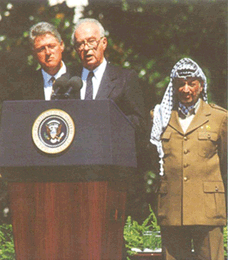 |
 |
 |
 |
| “We
say to you today in a loud and clear voice: enough
blood and tears, enough.” - Yitzhak
Rabin |
| |
 |
Rabin
speaking at the signing of
Oslo II |
ROAD
TO OSLO - Even as Yitzhak Rabin
basked in the successes of the Jordanian
peace treaty, an even
greater struggle had been going
on behind the scenes. The issue
of peace with the Palestinians was
one far too explosive to even slightly
broach to the public. In secret,
however, Rabin and Shimon Peres
had ordered teams of Israeli negotiators
to meet with Palestinian representatives
in London and the Norwegian capitol
Oslo. This series of covert meetings
went on for several months, mixing
blunt failures with encouraging
successes. Though the negotiations
were made painfully arduous by obstinance
on both sides, Rabin’s fierce
determination to forge a lasting
agreement paid off with the Declaration
of Principles, signed on September
10, 1993. It was the first formal
agreement with the Palestinians
; among other things, it called
for immediate transfer of limited
self-rule powers along with pullout
of Israeli forces from the cities
of Gaza and Jericho. The world barely
had time to react to the news before
Rabin flew to Washington D.C. to
seal the agreement with Yasser Arafat,
chairman of the PLO [Palestine Liberation
Organization] and de facto Palestinian
leader. As U.S. President Bill Clinton
watched, the two leaders joined
in a handshake that instantly rewrote
decades of history in the Middle
East.
 |
Rabin,
Clinton, and Arafat showcasing
the Seeds of Peace program |
 Rabin
was encouraged by the success of this
and the simultaneous negotiations
with Jordan. Despite the talks’
promise, however, Israeli conservatives
attacked the Oslo accords’ tenet
of exchanging land for peace, arguing
that sacred Israeli territory must
remain inviolate. Rabin nevertheless
barged through heavy opposition to
finalize a second agreement with the
PLO, dubbed Oslo II, which further
expanded on the breakthroughs of the
first treaty. This time, Arafat and
Rabin signed off on the lawn of the
White House, on September 28, 1995.
Across the Middle East, the shouts
of those who opposed the peace process
were overwhelmed by the visible changes
of the leaders’ initiatives.
Arab countries such as Morocco, Tunesia,
Qatar, and Oman all broke decades
of isolation to open official ties
with Israel. The possibility of Israeli
and Palestinian coexistence singlehandedly
revolutionized the entire region overnight,
culminating in an area economic summit
in Jordan during October 1995. Countries
and peoples who had lived in wary
unease for years now came together
to discuss the economic revitalization
of the Middle East. Rabin and his
partners in peace had accomplished
no small feat – and it would
not go unnoticed. Rabin
was encouraged by the success of this
and the simultaneous negotiations
with Jordan. Despite the talks’
promise, however, Israeli conservatives
attacked the Oslo accords’ tenet
of exchanging land for peace, arguing
that sacred Israeli territory must
remain inviolate. Rabin nevertheless
barged through heavy opposition to
finalize a second agreement with the
PLO, dubbed Oslo II, which further
expanded on the breakthroughs of the
first treaty. This time, Arafat and
Rabin signed off on the lawn of the
White House, on September 28, 1995.
Across the Middle East, the shouts
of those who opposed the peace process
were overwhelmed by the visible changes
of the leaders’ initiatives.
Arab countries such as Morocco, Tunesia,
Qatar, and Oman all broke decades
of isolation to open official ties
with Israel. The possibility of Israeli
and Palestinian coexistence singlehandedly
revolutionized the entire region overnight,
culminating in an area economic summit
in Jordan during October 1995. Countries
and peoples who had lived in wary
unease for years now came together
to discuss the economic revitalization
of the Middle East. Rabin and his
partners in peace had accomplished
no small feat – and it would
not go unnoticed.
|
| |
| |

 |
|
 |
 |
